Please Take Note: This is a review of the final game, but it might change slightly based on the success of the Kickstarter campaign. The game is being reviewed on the components and the rules provided with the understanding that “what you see is not what you might get” when the game is published. If you like what you read and want to learn more, we encourage you to visit the game publisher’s website or the Kickstarter campaign. Now that we have all that disclaimer junk out of the way, on with the review.
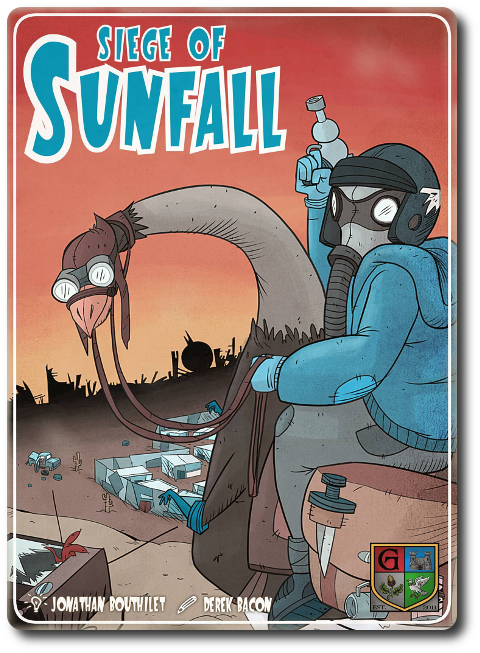
The Basics:
- For ages 8 and up (publisher suggests 12+)
- For 2 to 6 players
- Approximately 45 minutes to complete
Geek Skills:
- Counting & Math
- Logical & Critical Decision Making
- Pattern/Color Matching
- Strategy & Tactics
- Risk vs. Reward
- Semi-Cooperative & Team Play
- Hand/Resource Management
- Bluffing and Misdirection
- Bidding
- Worker Placement
Learning Curve:
- Child – Easy
- Adult – Easy
Theme & Narrative:
- Your enemy’s enemy is your friend, but only to a point
Endorsements:
- Gamer Geek mixed!
- Parent Geek approved!
- Child Geek mixed!
Overview
Sunfall is a desolate land, where nature and man have turned against each other. Now strange things wander the wasteland and the only way to survive is to work together. But not all alliances are binding and the line between friend and foe is thin.
Siege of Sunfall, designed by Jonathan Bouthilet and to be published by Grey Gnome Games, will reportedly be comprised of 6 Player mats, 6 Player screens, 53 Raider cards, 1 Siege Ends card, 88 Troop meeples (in 4 different colors), 57 Resource tokens, 3 Radiation tokens, and 2 Kaboom! tokens. As this is a review of a prepublished game, I cannot comment on the game component quality. Artist Derek Bacon has contributed his talents by illustrating the strange inhabitants that walk the wastelands of Sunfall. Below is an example of just a few of what the final game will reportedly contain.
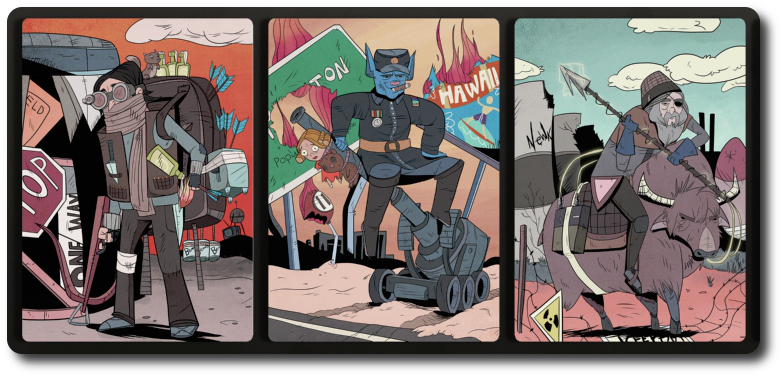
Dawn Breaks Over the Wasteland
To set up the game, first give each player 1 Settlement mat and 1 Player screen. The Settlement mat is placed in front of the player and should be visible to all opponents. The Player screen is also placed in front of the player, but is meant to hide cards and resources from opponents. It also contains reference material.
Second, give each player their starting Troop meeples. The number of starting Troop meeples is based on the number of players in the game. All starting Troop meeples are grey. These are placed behind the Player screen. All remaining Troop meeples are placed in a central pile to create the Troop pool. The Troop pool should be accessible to all players, regardless of their seated position.
Third, find and set aside the Siege End card and then shuffle the remaining cards. Deal an appropriate number of cards to the middle of the playing area, face-down, based on the total number of players in the game. This is the Raid deck. Set the card deck next to the Troop pool.
Fourth, split the Raid deck roughly in half and shuffle the Siege End card into the bottom half. Join the bottom half with the top half without reshuffling, placing the Raid deck face-down in the middle of the playing area.
That concludes game set up. Good luck…
Inspect Your Troops
The “Standard” Troop meeple (grey) is the backbone of the player’s Settlement. While they are not particularly strong in any specific area, nor are they weak. They are also the most versatile of the player’s Troops, capable of assisting in the daily operations of the Settlement and training in specialized areas of combat.
The “Ranged” Troop meeple (blue) represents those “Standard” Troops who have learned how to use ranged weapons, becoming deadly shots. They are particularly effective against Defensive Raiders found in the wasteland.
The “Assault” Troop meeple (red) represents those “Standard” Troops who have trained to ride into combat on beasts. They are particularly effective against Ranged Raiders who have difficulty hitting fast-moving targets.
The “Defense” Troop meeple (yellow) represents those “Standard” Troops who have learned how to fight and defend while wearing thick armor. They are particularly effective against the Assault Raiders who like to rush their foes.
Survival of the Craftiest
Siege of Sunfall is played in rounds and turns. The player turns and a round of game play are summarized here.
Step 1: Settlement Actions
The “Standard” Troop meeples can be used to explore the wasteland or stay behind and assist the Settlement. The “Standard” Troop is the only member of the player’s fighting force who is capable of assisting both passively or aggressively. All other Troop meeples (“Ranged”, “Assault”, and “Defense”) will be marched out into the wastelands to do battle.
Assigning “Standard” Troops to the player’s Settlement is optional. The Settlement mat represents the different areas where a “Standard” Troop meeple can be placed. They are as follows:
The Fields
Surrounding the player’s Settlement are 2 dry fields full of plants that are barely edible, but will feed a small population. Two “Standard” Troop meeples can be used here, 1 token per Field, to help work the land and feed the Settlement populace. Each Troop meeple assigned to the Fields will contribute 2 Resources each (for a maximum of 4 Resources) at the end of the round.
The Range
The Range is where the player sends Troops to practice their ranged weapon skills and become crack shots. Only 1 “Standard” Troop meeple can be placed in this location per round. If the player survives the round, the “Standard” Troop meeple is replaced with a “Ranged” Troop meeple that can now target enemies and drop them for a distance.
The Stables
The Stables houses the strange mutant beasts that now roam the land. Most are wild, but a few have been domesticated. The Stable contains the finest beasts the Settlement has to offer and they are ridden into the wasteland to help forage. Only 1 “Standard” Troop meeple can be placed in this location per round. If the player survives the round, the “Standard” Troop meeple is replaced with an “Assault” Troop meeple that can now rush into combat mounted on a beast of war.
The Garage
Anything made of metal or lost technology is brought to the Garage to be cleaned, fixed, and reused. While much cannot be fixed, the mechanics at the Garage have learned how to reuse pretty much everything, including finding new uses for old technology. The most popular is creating armor to protect the Troops. Only 1 “Standard” Troop meeple can be placed in this location per round. If the player survives the round, the “Standard” Troop meeple is replaced with a “Defense” Troop meeple that can now withstand a lot of damage.
Step 2: Reveal the Raid
Only after all players have completed placing Troop meeples on their Settlement mat does the next step in the round begin.
The top-most card in the Raid deck is drawn and revealed, placed face-up next to the Raid deck. The Raid deck contains cards that represent the trials and tribulations of the wasteland. But putting Troopers in peril will possibly lead to much-needed supplies.
Step 3: Bid
If the Raid card is a Raider, there are 3 important piece of information that each player needs to recognize. The first is the Raider’s strength value. This is the number that all the players must collectively beat by contributing their own Troop meeples. Second, the Raider type, which identifies it as a “Ranged” (blue), “Assault” (red), or “Defense” (yellow). Third, and finally, the Raider’s set reward, which will be given to the player who claims the card and is able to make sets with other cards they claimed during the round.
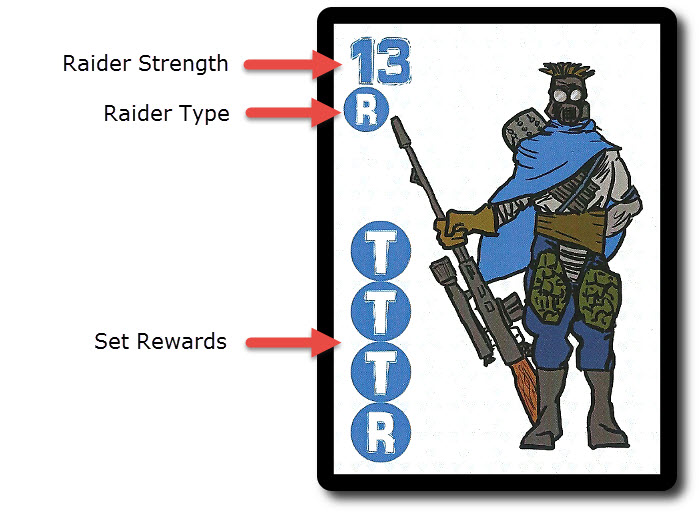
All players now look behind their Player screen and inspect their Troops. Their color makes a big difference at this point.
- “Standard” Troops are worth 1 strength
- “Ranged” Troops are worth 1 strength, but are worth 3 strength against “Defensive” Raiders (yellow)
- “Assault” Troops are worth 1 strength, but are worth 3 strength against “Ranged” Raiders (blue)
- “Defense” Troops are worth 1 strength, but are worth 3 strength against “Assault” Raiders (red)
Given the above, the player put any number of Troop meeples into their hand and then closes it in a fist. They then place their hand towards the middle of the playing area, signifying they are ready. Any player who has given the signal that they are ready cannot change their held Troop meeples.
The goal of all players is to collectively have a higher strength than the Raider card. This is determined by counting the values of all the Troop meeples and comparing it to the Raider strength. The secondary goal is to contribute only as many Troop meeples are necessary to either claim the Raider card or not. Once all the players are ready, the meeples are revealed and the results are determined.
Successful Raid!
- The total of all Troop meeples provided by all the players is equal to or greater than the Raider strength value.
- The player who pledge the most strength is awarded the Raider card.
- If there is a tie for highest pledged strength, the Raider card remains and can be claimed during the next raid into the wasteland.
- All players put their used Troop meeples into the Troop pool. The Only exception to this rule is if there was a tied pledge strength, in which case those player who tied for the most strength pledged keep their Troop meeples, placing them back behind their Player screen. All other players only get to keep half (rounded down) of their Troop meeples.
Failed Raid!
- The total of all Troop meeples provided by all the players is less than the Raider strength value.
- The player or players (if there is a tie) who pledge the lowest total strength are out for the duration of the round. They must also return all Troops to the Troop pool.
- The Raider card is discarded.
If the Raid card is anything other than a Raider card, the players still bid on it by selecting what Troop meeples to take and then showing their bid when everyone is ready. There is no chance of failure when bidding on a non-Raider card. The worst that can happen is that the player doesn’t get the card they are bidding on.
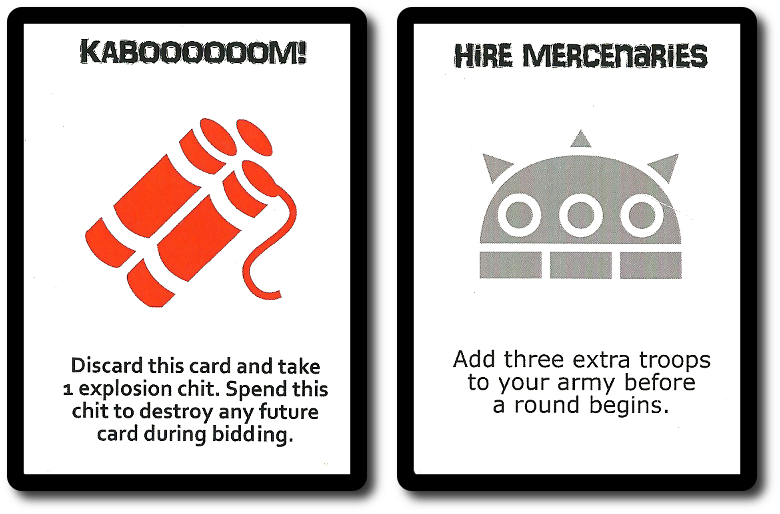
These special cards provide the following when collected.
- Hire Mercenaries: Can be discarded to obtain 3 “Standard” Troop meeples at the start of any round.
- Kaboom!: Discard to earn a Kaboom token which can be used during a pledge to destroy all opponent’s tokens and the card being bid on.
- Off to Forage: Owner of the card immediately earns 3 Resource tokens.
- Rad Attack!: Discard to earn the Radiation token which can be use during a pledge to contribute a strength of 2.
Step 4: Deeper into the Wasteland
The round now continues. The top-most card from the Raid deck is drawn and placed face-up. If the card from the last turn was left (because of a tie), players will be competing for both cards, but only need to beat the strength of the newly drawn card. Then the players bid and resolve. Essentially, a round is mostly repeating steps 2, 3, and 4 until the end of the round is reached.
Returning from the Wasteland
The round ends when the Siege Ends card is drawn, only 1 player remains in the wasteland, or all the players have been removed from the round. Whichever condition happens first ends the round, but not the game. Players now return to their Settlement, reassign new trained Troops, and collect the spoils of the wasteland.
If the round ends with the Siege Ends card, each player still in the round earns 1 bonus Resource token. They also earn 1 Resource token for every Troop meeple they still have.
Step 1: Resolve the Settlement
- “Standard” Troops assigned to the Field are returned to the Troop pool. If the player survived the round, they earn 2 Resource tokens per “Standard” Troop used in the Field.
- “Standard” Troops assigned training as a “Ranged”, “Assault”, and “Defense” Troop are placed back in the Troop pool and 1 specialized Troop meeple is taken and placed behind the Player screen.
Step 2: Resolve Sets
The cards collected during the game rounds are meant to be combined to create sets. By creating a set, the player earns additional Troop meeples and resources. The set rewards of the Raider card indicate the type and number. “T” indicates “Standard” Troop meeple. “R” indicates Resource token.
- “Three-of-a-Kind”: As soon as the player has 3 Raider cards of the same color, they must turn them in to collect the set reward. This includes during the round.
- “One-of-Each”: As soon as the player has collected 1 of each Raider card (1 yellow, 1 blue, and 1 red), they must turn them in to collect the set rewards. This includes during the round.
Step 3: Set Up Next Round
The next round is now set up by creating a new Raid deck and adding the Siege Ends card. Each player is also given a new batch of “Standard” Troops to be added with whatever remaining forces the player has behind their Player screen.
Begin the new round as described above and continue the game until it comes to an end.
Ending the Siege
When the Raid deck can no longer be created with the correct number of cards, the game is over. Players count their Resource token values and announce their totals. The player with the highest total has won the game.
To learn more about the Siege of Sunfall, visit the game publisher’s website or the Kickstarter campaign.
Final Word
The Child Geeks jumped right in and took charge. The players then fell into 2 distinct groups. Those who understood that winning would require cooperation and those who only looked after themselves. For those who worked together, they showed a surprisingly mature sense of “give and take”, focusing first on the survival of the group and then taking steps to secure their own goals. For those who did not, it was obvious that their pledges to the group were based on what they believed the card’s value to be. According to one Child Geek who was a semi-team player, “The game cannot be won unless the other players help you. That means you sometimes have to help them, too.” A Child Geek who believed only in self-preservation said, “The game is really hard. I don’t understand why the other players aren’t contributing more.” What it came down to was being engaged in the semi-cooperative game play that was necessary to advance everyone’s goals, while at the same time subtly influencing the game for a favorable resolution. For those who got that, the game was very much enjoyed. For those who did not, the game was painful and laborious. The end result was a mixed vote from the Child Geeks.
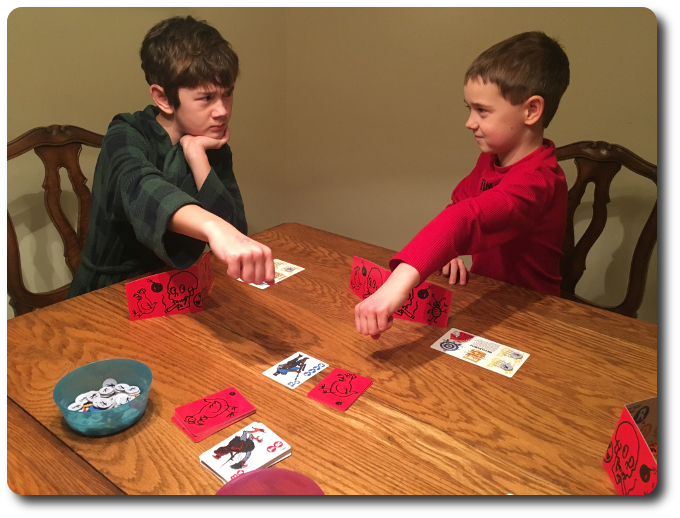
Cooperation in this game will only take you so far…
The Parent Geeks, of course, understood that Siege of Sunfall was a game where you had to work together, but everyone still had their own goals. According to one Parent Geek, “What I like most about this game is how much is visible to the players, and at the same time, how much is not. I don’t ever really know what a player is up to, but I do know enough to make a really good guess.” The Parent Geeks also liked how their Troops were used like money and how they were sometimes worth more than other times. As one Parent Geek put it, “It makes you realize the importance of diversifying your forces.” But by far, the most enjoyed aspect of the game was the collecting of cards. One Parent Geek said, “The cards are the core of the game and make it more than just about betting. The need to create sets and the values of those sets drives a player to take risks and to go out of their way to make things difficult for their opponents.” When all the votes were in, the Parent Geeks unanimously voted to approve the game.
The Gamer Geeks also understood the basics of the meta game that just below its surface. They appreciated it immediately, especially the complexity of managing resources, but halfway through started to grumble. According to one Gamer Geek, “I’m starting to feel like this game is a bit repetitive. I’m doing the same thing every round and for every card.” The special cards shook things up a bit, but not nearly enough to make the game feel fresh again. One Gamer Geek said, “I think the game is great, but too long for what it is. It should be 3 rounds of game play and then done. Working through the entire deck gets to be a bit much.” That pleased many of the Gamer Geeks, but left a number of them feeling that any “fix” for a game that required it to be cut in half was not a fix at all. According to one of these Gamer Geeks, “A great game for those who enjoy casual games, but it just didn’t do it for me. Too much of the same thing and for too long with not enough payoff at the end.” But Siege of Sunfall had its supporters, too. According to one such Gamer Geek, “This game is a great example of how you can take something as simple as betting and turn it into a semi-cooperative game of survival. I’m really liking this game and what it’s about. Imaginative, strategic, and tactical all the same time.” When all the games were over, the Gamer Geeks gave Siege of Sunfall a mixed endorsement.
Siege of Sunfall is all about tightly controlling your resources. Perhaps a bit too tightly, according to some of our players. I can appreciate their frustration with the game, as there is very little wiggle room. Making a mistake hurts and can kick you out for the duration of the round. When we consider that a round could be anywhere between 8 to 12 Raid cards, that’s a lot of possible downtime. It’s also difficult to make up for the time lost. Thankfully, no player really knows how well or bad off they are, which serves to keep everyone guessing if they need to risk more or less. But it also serves as a stresser. Thinking you are behind and making assumptions puts a player in a difficult position. They are already possibly hurting, so they decide to risk more. Will it pay off? That can only be determined at the end of the game.
But it is perhaps this game’s ridged stance on control and conquest that I enjoy the most. Each bid is a risk and also a dare. Do you risk putting in too much or too little in hopes that others will provide the necessary strength? Do you dare attempt to take the card from another player who you know has been collecting this particular Raider card for a set? This creates an entertaining and challenging semi-cooperative experience where your strongest allies are also your competitors.
The learning curve for Siege of Sunfall is easy. Learning how to play it well, is not. It took me several games before I felt like I was really getting a good grasp on how to be as competitive as possible. The game can also be played and enjoyed casually without the gnawing need to always win. Each round is straight forward, the results are immediate, and the turns are fast enough to keep everyone involved. A bit repetitive, according to some, but smooth nonetheless.
My only grip is that there is no way for me to change Resources to Troops. Which, honestly, sounds like a bad idea when the entire goal of the game is to earn Resources. However, I found a few times during the game that I had enough Resources to feel comfortable with my current position in the game, but short on Troops. I wanted to sell Resources to hire Mercenaries, for example. And why not? Sunfall is that kind of world, where food is the real item of worth. A nitpick, but a game rule I had wished for several times while playing.
As far as game length goes, it wasn’t as big a deal as some of the Gamer Geeks would have you believe. I found the overall game time to be between 20 minutes and 45 minutes. The speed of the game play is determined by how long it takes the players to think about what they want to do. This is not something you want to rush as each card that comes into play is something that must first be beat and then possibly won. Players must pause and consider what they should contribute and what they may possibly gain by doing so. It’s a great exercise in balancing the pros and cons, the risks and rewards, and attempting to guess what your opponent/teammate will do.
I have a hard time saying Siege of Sunfall is a light game, but nor is it heavy. It tasks the players to think pretty hard at times, but not always. Both casual gamers and elitist gamers looking for a filler will enjoy the game. As for me, I recommend it. It was a good time and challenging, always leaving me smiling. Give it a try if you think you have what it takes to survive the wastelands of Sunfall.
This game was given to Father Geek as a review copy. Father Geek was not paid, bribed, wined, dined, or threatened in vain hopes of influencing this review. Such is the statuesque and legendary integrity of Father Geek.



